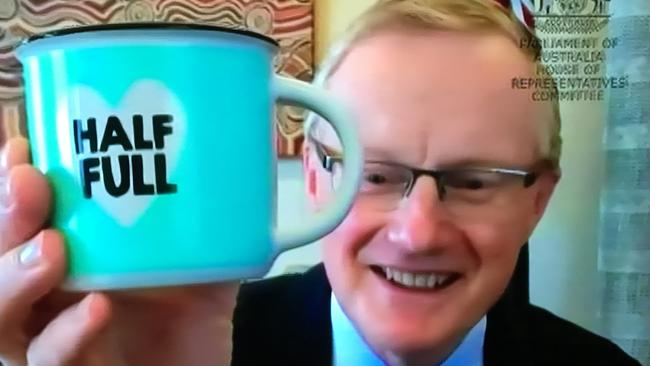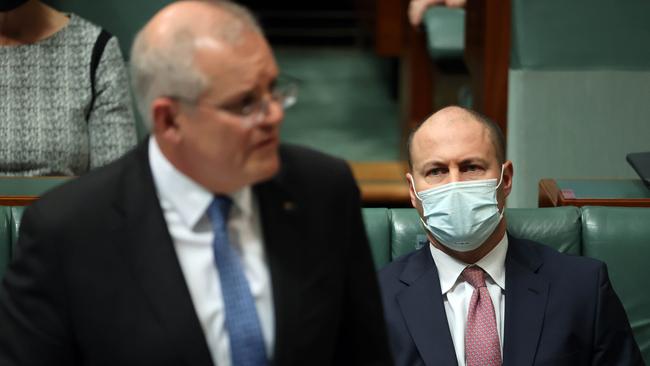Coronavirus: Delta lockdowns giving consumers the blues
Collective shock syndrome from endless lockdowns could plunge the economy back into negative territory.

These elongated lockdowns, as Greater Sydney enters its eighth week of strictures, Melbourne’s “short, sharp” loses its edge, and more regions are roped in, could change the pattern of consumption and kill off some of the animal spirits of commerce.
An election is due in the next nine months, so it’s unlikely the Morrison government’s mainstays will err on the side of fiscal caution. Temporary, targeted and proportionate – last year’s bywords – are about to get a thorough etymological workout. Hotspot and marginal seat may become synonymous.
The government’s key advisers assert a consumer strike would defy our pandemic experience. Trust the data, they say. Shoppers here have become adept at the post-lockdown splurge, which has kept consumer spending and the labour market ticking over for the past year.
The June quarter national accounts, released on September 1, will show the economy has grown for four straight quarters since the 7 per cent plunge in activity a year earlier.

Officials argue this crisis has been a supply-side disruption more than a demand problem, although that hasn’t stopped governments pumping in rescue dollars, now tax-free, at a startling rate. When shops are closed you can’t spend, the online renaissance notwithstanding. Of course, it hits services more than goods spending.
Even so, the stop-go rhythm and the boost to household incomes from future taxpayers have produced an excess of savings of $200bn, or 10 per cent of GDP. That is, over and above what we’d normally squirrel away and it gives some hope this bonanza will be liberated locally before it is allowed to be spent overseas.
But this on-again, off-again existence may be doing people’s heads in and that dent to our collective mindset could extend into the latter months of the year and, in a worst-case result, lead to a double-dip recession. Even mug-carrying optimists at the Reserve Bank are wary of a snap to the reliable snapback.
A week ago, appearing before the house economics committee, RBA assistant governor Luci Ellis, in charge of the bank’s economic analysis and research, noted the judgment that “spending bounces back quickly is based on actual data”. “Many countries that have been coming out of lockdowns have found that things have come back faster than they might have expected. This isn’t like a demand shock. This is people who were prevented from being able to spend who are now going to be able to do so again,” Ellis said.
“They get to go and do things that they like doing, like going to restaurants and having haircuts and seeing their friends and family, and so they go and do it.”
But West Australian MP Celia Hammond asked if it was possible, the longer this goes on, that people’s purchasing behaviours will become more subdued?
During his parliamentary appearance, RBA governor Philip Lowe was asked by Hammond about the worst-case scenario. “It’s hard to know what our collective psychology is going to be like after we come out of it, and let’s hope that we come out of this towards the end of the year,” Lowe said.
“It’s possible that we’ll become more risk-averse because we’ll think, ‘Well, this could happen again’, and we’ll tighten up our belts. We don’t know that.”
Still, Lowe conceded, “the longer this goes on and the more repeated it is, we can’t rule out some collective shock psychology”.
On balance, the RBA expects a fall of 1 per cent in GDP this quarter, followed by a 2.4 per cent bounce in the final three months of the year. The bank’s baseline scenario for growth, however, is seen by private sector economists, many of whom reside in Sydney, as far too optimistic.
The emerging market consensus is that things will get a lot uglier in the economy until lockdowns are behind us.
“We think the near-term economic outlook is poor, given that the extended lockdown in Greater Sydney looks unlikely to be lifted for a while yet and snap lockdowns elsewhere are currently the playbook if new outbreaks occur,” CBA’s Stephen Wu said. “Spillovers to other states are a risk and could slow the economic recovery.”
In the RBA’s quarterly statement on monetary policy, the bank sketched out a possible slower growth path if the spread of the Delta variant (or other new variants of the virus) in Australia results in more extended lockdowns. In this scenario, around half of the population experiences rolling lockdowns during both the September and December quarters and a full opening of the international borders is delayed until much later in 2022.
That would lead to a larger initial decline in activity and, subsequently, a slower pick-up in growth. The RBA said extended lockdowns dampen consumer and business confidence, while the slower return of international travel delays the services revival.
As well, households would increase saving, not only as a precaution but because there are fewer opportunities for discretionary spending. In this scenario, the RBA says consumption is 4 per cent lower at the end of 2023 than in the baseline case.
Prolonged restrictions and lower spending growth reduce business income and prompt companies to delay investment plans and lay off more workers. The jobless rate rises over coming months and remains above 5 per cent until the end of 2023, which also holds down wages growth.
Being economists, the RBA also outlines an upside scenario, predicated on faster rates of vaccination, fewer lockdowns and earlier reopening of international borders.
But uncertainties abound, given some relationships in the economy may have been fundamentally altered by the pandemic, particularly around wages and inflation, the bank notes. As well, there are questions about the outlook for asset prices, especially property values, which may be cooling, and a sharemarket that hit new highs this week. The so-called “wealth effect” has underpinned the stronger-than-expected recovery pre-Delta lockdowns. But the RBA says asset price growth could slow or even reverse in some circumstances.
“For example, in the case of housing, the supply of new dwellings is likely to outpace population growth over the next few years. If this weighs on housing prices, household wealth and consumption growth could be lower than otherwise,” the quarterly statement said, before hedging with an alternative universe where asset prices keep rising on ultra-cheap money.
What is our collective mindset? Defence or attack? Grind it out or splash out on a little life? Measured consumer sentiment tells us lockdowns are hurting buyers’ moods, especially in NSW. But shoppers are still believers in snapbacks, particularly those surveyed who have been vaccinated or intend to get a jab.
When Treasury estimated the costs of managing Covid-19 at different vaccination levels modelled by the Doherty Institute, it only looked at the direct hit to GDP under a range of scenarios. It did not look at the effect on business and consumer confidence, the “scarring” effects of higher unemployment or the deterioration in the budget.
Still, the bottom line was that the higher the vaccination rate, the lower the cost to national output, assuming baseline restrictions and fast action by governments. According to Treasury, at 50 per cent vaccination rates, if governments are getting on top of early cases, it’s costing the economy $570m a week; at 80 per cent vaccination rates, it’s $140m a week.
Lowe maintains the risk of a double-dip recession is quite low. “We just need at least some little bit of opening up by the time we get to October, November, December to have more economic activity than we’re having right now,” he told the committee.
Vaccination, broad and swift, is the only way to break out of our collective shock.






Et tu, Canberra? The bubble has burst. With many Australians now subsisting under some form of restrictions, Covid-19 funk could curdle into a deeper economic malaise.